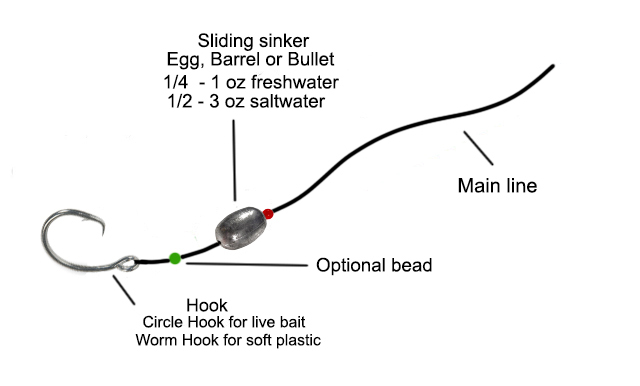The knocker rig it the go-to presentation for savvy anglers targeting bottom-dwelling species that hold tight to strucure like reefs, wrecks, piers, pilings, and rock piles. The sinker on the knocker rig stirs up debris as it drags along the bottom drawing fish from their cover, and it’s easy to free when it gets hung up.

The moment they feel a hookset, bottom-dwelling species such as snapper and grouper hightail it to the safety of nearby structure where hook and line can get hung up. Let out some slack on your line, allow the sinker to come to a rest on the bottom, then give the line a tug, and the knocker rig usually pops free.
How it Works
The knocker rig is simply a loose egg sinker on a leader line. It’s this simplicity of design that makes it one of the best rigs for fishing heavy cover and structure. When lowered through the water the sinker and bait stay together until they reach the bottom. When fished in a heavy-growth reef, this presentation keeps the knocker rig from immediately tangling.
Conventional fishing wisdom would suggest using the lightest weight possible to carry and hold your bait to the bottom. The knocker rig defies conventional wisdom. With the knocker rig, lighter isn’t always better. You want a sinker weight heavy enough to keep you solidly on the bottom at all times. This also means when fishing from a boat, you’ll need to lower and raise your rod in sync with the lowering and rising waves to ensure your rig to keep your sinker on the bottom.
While you don’t want overdo it, you also want a sinker that is sufficiently hefty that you’re able to maintain the feel of the sinker on the bottom, and sense even the slightest activity on your line. There is, however, one scenario where using lighter sinker makes sense.
Techniques for Fishing a Knocker Rig
The knocker rig is a bottom-fishing rig used primarily for fishing structure. Cast it and let it sit on the bottom with the bait flowing freely, or drag it along the edge of structure to stir up the bottom and draw fish from their cover.
When baiting snappers adjacent to high-profile structure or targeting kelp bass in kelp gardens try fishing the knocker rig with a lighter weight sinker. The lighter sinker allows the bait to fall through the water column a bit slower allowing additional time for suspending fish to strike. A knocker rig is well suited for fishing kelp gardens since it keeps the bait, hook, and sinker together throughout the descent preventing tangles.
In addition to targeting a large variety of bottom-dwelling saltwater species, the knocker rig is also effective for fishing catfish from the bank. The knocker rig will greatly increase your casting distance from bank when using large baits making it possible to target specific structure or get out to deeper water.
Knocker Rig Materials
The most important element of a knocker rig is the sliding sinker. You can use an egg, barrel, or bullet sinker, but an egg is most popular. For fishing saltwater species including snapper and grouper, an ideal sinker weight is going to be between 1/2 – 3 oz. Sinker size will be influenced by water conditions, current, and fishing technique. For suspend fishing you can go with a little lighter weight. When currents are strong, you may need a heavier weight to keep your rig on the bottom. For most freshwater applications, a sinker in the 1/4 – 1 oz range will do the trick.
There are a variety of hooks you can use when fishing a knocker rig. The two most common are a standard worm hook and a circle hook. A worm hook is ideal when fishing soft plastics. Circle hooks are best for fishing live and cut bait. Depending on where you’re fishing a circle hook may be required by law. Circle hooks are required when fishing off the Gulf Coast to minimize gut hooks. For targeting most bottom-dwelling saltwater species such as sea trout, targpon, snapper and grouper a 4/0 to 5/0 hook is your best bet. If you going after goliaths you’ll want to up your hook size to a 6/0 or 8/0. For fresh water fishing a 2/0 to 4/0 hook will work.
A knocker rig can be setup on just a main line, or you can have a main line with a leader. When using a leader line, you’ll attach the leader to the main line using us a barrel swivel or a snap swivel. For leader use 3 to 4 feet of 20-30 lb test monofilament or fluorocarbon. For your main line a 30 to 50 lb test braid is recommended, but some anglers prefer monofilament and will increase test weight to 80 lbs when targeting larger fish.



